For a printable PDF of all the stories for June, click on the following link:
PENNSYLVANIA OFFICIALS DEBATE SOLAR FARM AS AG USE
BY DEBORAH BOWERS, Editor & Publisher
EAST DRUMORE, PA – A proposal to construct 83,000 solar panels on 80 acres of a southern Lancaster County farm has local and state officials differing on whether the use would be good or bad for agriculture, agricultural zoning, and farmland preservation goals.
The proposal started as a 5-megawatt facility but the company, Community Energy, increased its plan to a 15-megawatt operation. It would be constructed on Class I and II soils, on a property that is nearly surrounded by preserved farms. Community Energy said the location is optimum for its project both for sun exposure and proximity to an electric substation.
The Lancaster County Planning Commission unanimously opposed the project in April on grounds that it would set a bad precedent for Drumore Township’s zoning ordinance governing agricultural uses. The company has requested an amendment to the ordinance that would expressly allow solar installations. The county’s Planning Commission only serves in an advisory role.
Township supervisors are at least one month away from voting on the company’s application, according to Supervisor chairman V. Merril Carter, who noted that the company’s cost in building the installation would be “one-third stimulus money.” Because the company’s request requires a zoning change, a public hearing is necessary, Carter said. No hearing date has been set.
Township and county officials differ in their assessment of whether allowing a solar farm to be built will hurt the community’s farmland preservation efforts. Township officials themselves differ on that point.
The company states the solar farm would be under a 25-year lease and that the solar panels could then be removed without harming the land.
Pa. Secretary of Agriculture Russell Redding agrees the solar power installation would be harmless to both the ground its built upon and the goals of farmland preservation.
In an interview with FPR following a recent state board meeting that marked the board’s preservation of its 4,000th farm, Redding stated the proposal posed no conflict for farmland preservation objectives because once removed from the site, soils would not be compromised. Redding stated his department’s policy, however, was to point solar proposals away from prime soils.
“Our point, to proponents and to the companies that want to do this, is ‘please don’t come in here with proposals for solar farms on Class I and II soils.’” Redding said he would have preferred a different site for the current proposal, which is comprised of Class I and II soils.
Pennsylvania’s farmland preservation program does not include commercial solar or wind installations as an allowed use on preserved farms, according to program director Doug Wolfgang.
“Solar and wind facilities are permitted by policy if energy is primarily for use on the farm,” Wolfgang said. All Pennsylvania counties have rural enterprise zones that govern alternative energy production, and a county farmland preservation board can approve a plan for energy production for farm use, Wolfgang said. When a plan is questionable, Wolfgang advises boards on what is acceptable, but admits that at some point the line between farm-use and commercial-level production will have to be drawn.
“It’s evolving day by day and it’s something we’ll be addressing, whether through legislation or policy.”
Redding said his support for the East Drumore plan is not in conflict with farmland preservation rules because the program is based on voluntary participation and a statement of intent.
“The owner of the land has declared their intended use of the land and if you declare that in the form of an easement, that is forever. I think that’s a very different statement than, ‘I’ve got the farmland but haven’t taken the step to put an easement restriction on it.’ I think we have to look at that in our consideration of where we place renewable energy. I think if we’re serious about energy independence we’re going have to look at where to put those farms and how do you best use the land resources that you have to accomplish that. Clearly we would not support putting them on preserved farms, because those folks have stated very clearly their intention to keep that farm in a productive agricultural state.”
New Jersey earlier this year passed legislation allowing solar installations on farms, with separate rules for preserved farms that allow up to 10 percent energy generation beyond the need of the farm. No more than one percent of a farm’s land area can be used in an installation. In just a few months, and before the law becomes effective July 1, large proposals have surfaced, including a 21-acre plan for a farm in Upper Deerfield in Cumberland County and a 500-acre proposal in Upper Pittsgrove Township in Salem County, at 80 megawatts, the state’s largest proposal to date.
The New Jersey proposals, if approved and built, will give the public a taste of what their legislators approved this past January. The New Jersey Farm Bureau gave the legislation a thumbs up, but many are unsure whether a “crop” that looks more like an industrial park will stand up to the heat of public opinion. While the farm bureau supported some commercial sale of farm-produced energy, it does not agree with proponents of solar farms that sun rays qualify as a crop.
Proposals for energy plants on preserved farms will be reviewed by the State Agriculture Development Committee (SADC), which administers the state farmland preservation program. No applications for solar installations on preserved farms have been received, according to SADC spokesperson Hope Gruzolvic.
“We’ve had inquiries, but we can’t consider applications until we resolve the question of whether we need to adopt rules first,” she said.
MALPF again to combine two funding years into one round in 2010
ANNAPOLIS, MD — Maryland’s farmland preservation program will combine two years’ funds into one application round, combining FY 2011 and 2012 allocations. The last easement cycle combined FY 2009 and 2010 funds.
MALPF will have $11.8 million for easements, which will leverage up to $8 million in county matching funds. Federal funds are not likely to be available for FY 2011 offers, said program director Jim Conrad.
County programs were asked for their preference for having the application deadline occur in 2010 or 2011, and votes came in nearly evenly split.
According to Conrad, the official deadline has been set as this July 1, but “MALPF is only requiring that count[ies] forward the applications they have solicited and approved to MALPF staff no later than October 15, 2010.
National Trust selects new president
WASHINGTON, D.C. – Stephanie Meeks, 45, a member of the board of the Potomac Conservancy and formerly with The Nature Conservancy, will replace Richard Moe as president of the National Trust for Historic Preservation effective in July.
“All of us who have met Stephanie believe she is the ideal person to lead the organization at this critical point in its history,” said Cliff Hudson, chairman of the board. Hudson said Meeks has “impressive experience in leading large organizations, including The Nature Conservancy and most recently Counterpart International.”
Richard Moe, 72, announced his retirement in Nov. 2009. He headed the Trust for 17 years, the longest tenure of any president in the Trust’s 60-year history. Moe broadened the organization’s goals by advocating smart growth and land preservation.
At the time of his announcement, Moe said he is proud of weaning the National Trust from reliance on federal funding more than a decade ago and in the process nearly doubling the annual budget to its current $55 million. He said he is also proud of the National Trust’s role in preventing the Disney Corp. from building a theme park in the historic Northern Piedmont of Virginia, among other interventions, including restoring historic structures in New Orleans following Hurricane Katrina.
Moe had earlier served as chief of staff to Vice President Walter Mondale and a member of President Carter’s senior staff from 1977 to 1981.
Meeks said she plans to continue Moe’s objectives, “to broaden the reach of the National Trust to encompass the protection of consequential places at the heart of all of our communities. At this time in our history, we have an opportunity – and a need – to embrace what makes our individual communities unique and authentic and celebrate and preserve those qualities.”
Pa. marks 4000 farms preserved; Lebanon County family honored
BY DEBORAH BOWERS, Editor & Publisher
MYERSTOWN, PA – A dairy farm in Lebanon County with expansive views of cropland recently became the 4,000th farm to be preserved in Pennsylvania and the owners hosted a celebration of that milestone June 10.
The Zimmerman family was bestowed with several citations from elected and state officials.
Pa. Secretary of Agriculture Russell Redding told a crowd of about 65 people that the state would continue a relationship with owners of preserved farms beyond preserving their land.
“You have our commitment as we move forward. We know the preservation step is the first step. That’s a strong statement by your family and families, but it’s also a strong statement about the Commonwealth’s commitment to you.”
Sec. Redding said the state’s Center for Farm Transitions plays a significant role in the future of preserved farms.
“We had the farmland preservation program in mind, because it really is a transitions discussion. This farm is entering another phase of that transition … what happens in the years to come in terms of transitioning this operation, to make sure it remains economically viable and a productive asset to both Lebanon County and to Pennsylvania.”
Redding thanked all the governmental and nonprofit partners and others working for farmland preservation in Lebanon County, including a group of young women, who Redding asked to come forward, who were wearing their dark blue FFA jackets and black skirts.
“This is the future of agriculture in Pennsylvania,” Redding said. The girls were wearing their jackets for the last time before graduating high school.
Pa. Bureau of Farmland Preservation director Doug Wolfgang served as emcee for the event, which concluded with local homemade ice cream and cake in the Zimmermans’ barn. Farmland preservation program administrators from nearby counties attended the event.
The 4,000 farms now under preservation in the state comprise more than 425,000 acres.
STATE BRIEFS
In West Virginia … The Jefferson County Farmland Protection Board is looking into nutrient credit trading as a possible means for boosting farmland preservation funding and supplying the credits sought by the county’s Public Works District (see story May 2010). The PWD purchased nutrient credits from Pa. last month because no program exists in WV. Legislative changes must take place before such a program could operate.
In Virginia … Gov. Bob McDonnell signed the state’s biennial budget May 17. The Office of Farmland Preservation will have $100,000 (that’s one hundred thousand) for each of 2011 and 2012 for matching funds to the state’s certified local programs. Last year 16 localities had certified programs. Localities must be re-certified annually.
In North Carolina… The NC Sustainable Local Food Advisory Council adopted a resolution this Spring urging the General Assembly to allocate $5 million to the Agricultural Development and Farmland Preservation Trust Fund. The Council was formed in 2009 to address food system and land use concerns. “It is critical to integrate farmland preservation into the development of a sustainable local food economy,” the resolution stated. The fund would help stimulate the economy, the Council stated. The Trust Fund’s $2 million was cut as lawmakers looked to plug an $800 million deficit.
In New York … The NY Environmental Protection Fund has been on a roller coaster ride through Albany’s budget season, but for now is surviving the budget process at $134 million, down from $212 million last year; the budget, however, is not yet adopted and is more than two months overdue. Gov. Paterson told the legislature June 16 to get it done or he will get out the budget ax. The state faces a $9.2 billion deficit.
The NY legislature did pass a law that will enable land trusts to apply for farmland preservation grants directly to the Dept. of Agriculture and Markets. Land trusts until now had to apply to local governments for the grants and work under contract with those localities.
Land trusts have shouldered about 75% of grants to date, according to Deputy Agriculture Commissioner Jerry Cosgrove.
“It made sense to allow them to apply directly for funds (albeit still with approval from County Agricultural and Farmland Protection Boards and local municipalities)…we hope that the net result will be that we will be able to complete the projects in a more timely manner.”
In Michigan … Kent County Commissioners face tough choices in funding their PDR program that, when created in 2002, was charged with operating on private funds. Foundations are asking for matching funds that are higher than last year’s, and a vote on matching was tabled June 15.
Land trusts called on to partner with farm bill conservation programs
BY DEBORAH BOWERS, Editor & Publisher
REISTERSTOWN, MD — Farm bill conservation programs in need of outreach assistance, and how land trusts can fill that need, was a featured theme of a one-day conference in Baltimore County May 27. About 65 conservation practitioners attended the conference sponsored by the Maryland Land Trust Alliance.
Land trusts are in a position to become the “outreach assistance” for USDA conservation programs, said Aimee Weldon, director of restoration for the Potomac Conservancy.
Weldon led a morning session on financing conservation through farm bill programs and then moderated an afternoon panel that included Mark Rose, assistant state conservationist for programs for Maryland NRCS, Tom Morgart, program manager for the Chesapeake Bay Watershed Initiative at NRCS, and Toby Lloyd, farm programs chief for Maryland FSA.
More than $24 billion in the 2008 farm bill is slated for conservation programs of all types, Weldon said. Because funds for personnel to help that money reach landowners has been continually cut, the programs need partners, like land trusts, to step in and promote the programs, she said.
“Land trusts can talk about these programs, understand the options, and communicate them in a way that is not ‘government speak,’ ” Weldon said in an interview.
While her panelists represented farm bill programs as they are administered at the state level, Weldon said county-level programs “are where the rubber meets the road,” and those administrators are handling hundreds of landowner requests. “They are racing just to stay in place,” she said. “That’s why land trusts are needed.”
Weldon said land trusts can’t sit back once development potential is removed from land.
“Protection alone is insufficient. We need to do more than protect land. We now need to be involved in restoration and management.” And since the USDA “lacks the capacity to conduct outreach,” this is an opportunity for land trusts. But that opportunity is a daunting one, which Weldon compared to shopping at T.J.Maxx, a discount department store known for its cram-packed and disheveled clothing racks.
Weldon outlined the top programs for restoration work that land trusts could help implement, including FRPP, CREP, WHIP, EQIP and the CSP. She said land trusts should focus on the economic benefits to the landowner.
Panelist Tom Morgart said President Obama’s executive order marking the Chesapeake Bay as a national treasure mandates that agencies work together to try to clean up the Bay. Increased outreach is essential to that mandate, he said. “It’s a lot about partnership and reaching out to everyone we can.”
Morgart said the science behind nutrient management and determining TMDLs (total maximum daily loads) “won’t be easy. They will affect everybody – cities, individuals, and farmers.”
“Nutrient credit trading is going to be hard for a couple of years,” Morgart said in response to Charles Conklin of the Gunpowder Valley Conservancy. Conklin said he was against credit trading because payment “doesn’t come until the baseline is determined and right now nobody knows what the TMDL is.” Asked who would certify the baseline, Morgart admitted he didn’t know.
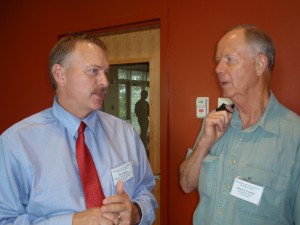
Charles Conklin (right) of the Gunpowder Valley Conservancy, speaks with NRCS program manager Mark Rose (FPR photo)
Maryland this year codified nutrient credit trading, formalizing a program being developed by the state Dept. of Agriculture. MDA was awarded a $512,000 Conservation Innovation Grant (CIG), one of the grants mentioned by Morgart as being wide open for land trusts – available for trying new ideas for natural resource protection. MDA’s grant will enable implementation of point and nonpoint source nutrient credit trading.
Toby Lloyd, farm programs chief for FSA said the agency is “looking for innovative outreach for our programs.” He said “Beefing up CREP” would soon be on Facebook and YouTube.
To date, the only land trusts to take advantage of the CIG grants are The Nature Conservancy and Western Pennsylvania Conservancy. A unique feature of the CIG grant, important for land trusts, is that it includes funding for administrative costs.
WEST VIRGINIA TO BEGIN STATE EASEMENT PURCHASES
BY DEBORAH BOWERS, Editor & Publisher
CHARLESTON, WV – Ten years after enacting a statewide purchase of development rights program, West Virginia is about to purchase easements for the first time at the state level. Until now, the state has been providing technical assistance to counties to help them start their own programs. But only 17 of the state’s 55 counties have been able to do so over the last decade.
“The Authority is taking applications from counties without local boards…it’s a pretty big shift for me,” said Lavonne Paden, state program manager. Paden has been a circuit rider administrator, helping counties create programs and get them operating. The legislature enabled counties to enact local real estate transfer taxes in 2000 to fund farmland preservation.
Now, the state has its own dedicated fund as well. Paden said the State Agricultural Land Protection Authority has been collecting revenues over the last two years from a recordation fee enacted in 2008. It has generated about $800,000 per year and now stands at about $1.5 million, she said. Meanwhile she has been busy developing a state program.
“We’ve helped one county. The remainder will be announced in August.”
More is at stake for the counties that don’t yet have a program, Paden said, because the state is swimming in federal matching funds. Last year West Virginia got $5.4 million from the Farm and Ranchland Protection Program (FRPP) and so far this year has received $4.1 million, according to Paden and the state NRCS office.
“Because a lot of states can’t match, we’re getting as much as we can use… we’ve just been really aggressive getting the deals done.”
Four other states received between $5 and $6 million in 2009; Pennsylvania, the nation’s leading program, received $4 million and New Jersey received $8 million in 2009, the highest sum.
Paden said West Virginia counties beginning this year will benefit from what she calls a “single point agreement” with the NRCS. If a project falls through, that money can be moved to another county. “All we’re doing is being the paymaster, basically,” she said.
In 2000, Virginia also passed a statewide farmland preservation program, but West Virginia went a step farther by enabling counties to actually fund PDR. While Virginia localities struggle with extremely little funding assistance from the state over the last decade, West Virginia lawmakers unanimously passed SB 209, which authorized local transfer taxes. The law also authorized county farmland protection boards and charged them with establishing standards and guidelines for eligibility, based on property use, improvements, size, location in relation to other farms, and threat of conversion.
Local boards were also charged with seeking funds, but the state Authority, too, was charged with applying for and obtaining “all state and federal funding available” for farmland preservation.
Both the state Authority and county boards can acquire easements or lands in fee for resale with easements. All easements are in perpetuity.
Counties that stepped forward to establish their own programs nearly a decade ago have preserved 89 farms and 11,475 acres. Most of that acreage is in the state’s easternmost counties – Berkeley and Jefferson, which stretch out toward the drivable outer suburbs of Maryland and Washington, D.C.
Pennsylvania administrators meet; state budget is top concern
BY DEBORAH BOWERS, Editor & Publisher
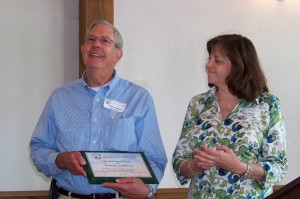
Program administrator Norm Lathbury is recognized by his colleagues. Ellen Dayhoff looks on. (PFPA photo)
HOLLIDAYSBURG, PA – The fear of more budget cuts to the Pa. Dept. of Agriculture and particularly to the state Bureau of Farmland Preservation overshadowed the Spring conference of the Pennsylvania Farmland Preservation Association (PFPA) May 20.
“Our concern is keeping the program running,” said Ellen Dayhoff, program administrator for Adams County, who attended the meeting. “The state budget was a big issue. The bottom line is, there is no money, anywhere.”
The Bureau has had staff cuts the last several years, going from nine employees to three and a half.
The group brightened the meeting with a recognition award to longtime Association supporter Norm Lathbury, program director for Centre County. Lathbury was noted for his dedication and leadership in founding the group.
The Association’s voting members agreed to support legislation that would prohibit preserved parcels under one deed from being sold separately, requiring that they “be merged prior to sale of the easement,” Dayhoff said.
The group also supports legislation that will allow counties to receive up to $10,000 per year for computer and GIS upgrades used for farmland preservation. The legislation would remove the existing Grant Assistance Program’s $25,000 per-county cap. The legislation would authorize up to $200,000 annually to assist counties, with funds from the future sale of state owned lands. The program, which has existed since 1994, last made awards in 2008.
“We’re hoping to open another round later this year,” said Doug Wolfgang, executive director of the Bureau of Farmland Preservation.
Twenty-eight PFPA members attended the conference in Hollidaysburg, a small town south of Altoona. The PFPA meets twice annually and will next meet this Fall in Gettysburg.
MIKE MCGRATH
Strike while the iron is hot!
BY MIKE MCGRATH, Contributing Editor
Opportunities like this only come along once or twice in a lifetime. Now is the time to preserve farmland. In Delaware we’ve seen declines in land values over the last two years of 40% – 50%. Real estate developers just aren’t making deals for land. At the same time farm prices have been good, margins reasonable and net farm income respectable. It’s a good time to buy farmland. That means it’s a good time to buy conservation easements on agricultural land. But state and local budgets are under real stress and preservation dollars are scarce. And all this means that competition among landowners who want to preserve their land is at an all-time high.
Here in Delaware we just completed the acceptance of some 36 farms for permanent preservation – with more to follow in a few weeks. This time around the average discount offered (belowmarket value of the easement) by the successful bidders was 73%! Along with the slippage in appraisals that means we were preserving land at “fire sale” prices. And we will still have more than a hundred farms waiting to be preserved next year.
Those of us working in the “vineyard” of farmland preservation cannot afford to pull back at this critical moment. We need to push harder than ever with our constituents and leaders to get additional funding right now for preservation. We need to find as many partners as possible that have money to work with us. And we need to keep encouraging USDA to get the money on the ground, sooner, rather than later. And we need to press home two key arguments for funding now.
First, we won’t get any better bargain than farm preservation right now. Prices are down and landowners are anxious to preserve their land. The savings that are realized in the public sector when we protect land from rampant sprawl are needed right now. Legislators are now realizing that the bill for the costs of sprawl are now coming due – new roads, new schools, new bus routes, more police and ambulance – and are costing BILLIONS! Now, they can be convinced (easily, I hope) that preservation is one, cheap way to avoid the crushing costs of development. The bargain of preserving farms should be apparent.
Second, there is the matter of jumpstarting the economy. We should be arguing that farmland preservation is one of the best economic stimulus packages anywhere around. Our studies here by the University of Delaware showed that over ¾ of farmland preservation payments get “plowed” back into the local economy. These funds are used to retire debt (circulating more funds in the ag banking system), build farm buildings, purchase irrigation equipment – and the list goes on. We know from many studies of the agricultural economy that the multiplier factors are high for ag industries meaning that many other sectors are impacted – and almost entirely on the local level. Farm preservation funding will have a much larger and more local impact on our economies than laying more asphalt!
So, let’s not be shy! Now is the time to spend more money on farmland preservation, not less. We’ve got the facts – we’ve got the farms – now we need the funds. Strike, while the iron is hot!
Mike McGrath has been chief of farmland preservation in Delaware since creation of the Delaware Agricultural Lands Preservation Foundation in 1991. Since then, he has overseen the preservation of 564 farms comprising 93,935 acres at a cost of $158 million.
TOM DANIELS
Is it time for another National Agricultural Lands Study?
BY TOM DANIELS, Senior Contributing Editor
Lately, the American Farmland Trust has been calling for a new National Agricultural Lands Study (NALS) which would update the study Congress authorized way back in 1981. While better information on what is happening to America’s farmland is certainly welcome, the real problem is how the US Department of Agriculture conducts the Census of Agriculture and how the NRCS gathers data for the Natural Resources Inventory (NRI).
Both of these reports appear every five years and rely upon landowner responses to a mailed survey. That is, the reports are based on a sample of landowners, and landowners have little incentive to be accurate when filling out the survey. Not surprisingly, the results, especially for county-level estimates of land in farms, are far from reliable. For instance, the last two Ag Census reports have shown losses of thousands of acres in Marin County, CA which has tough one house per 60-acre (1:60) zoning, more than 40,000 acres of preserved farmland, and about one-third of its land area under federal control.
Equally unrealistic is the finding in the 2007 Ag Census that farmland acres in Lancaster County, PA increased from 2002, even though county planning department data show development consumes about 1,000 acres of farmland each year.
Despite claims from USDA statisticians that these improbable reports resulted from a changed definition of farmland for the 2007 census, something doesn’t look right in Marin and Lancaster: the data aren’t accurate and that means they aren’t useful. And Marin and Lancaster are not likely alone.
Instead of another NALS study, the USDA and NRCS should put modern technology to use. Better data on farmland change should be available from satellite remote sensing and geographic information system (GIS) databases. These databases may be expensive to establish, but would be relatively cheap and easy to update, and more often than every five years and in a more timely fashion – something that hasn’t been a strong point for the NRCS — the 2007 Ag Census was published in 2009 and the 2007 NRI appeared in 2010.
Finally, the 1981 NALS study included a pioneering description of farmland protection and preservation techniques, many of which were still in their infancy. Since then, information and experiences about protecting and preserving farmland have become widely available, but accurate and reliable data have not. Instead, the need is for regular GIS-based reports on farmland conversion from USDA and NRCS. A good model is the State of California’s Farmland Mapping Program( http://www.conservation.ca.gov/dlrp/FMMP/Pages/Index.aspx). Such reporting would help state and local governments and land trusts understand what is happening to farmland and assist in their review and upgrade of their farmland protection and preservation efforts. Some state and local governments might even recognize the need to form new programs to retain their farmland.
Tom Daniels is senior contributing editor of Farmland Preservation Report. He teaches at the University of Pennsylvania, Dept. of City & Regional Planning and has a background in agricultural economics. For nine years, he administered the Lancaster County Agricultural Lands Preservation Program. He is the author of numerous books on environmental planning, small town planning and farmland preservation.
BACK PAGE BRIEFS
MALT 15-year veteran Elisabeth Ptak steps away to travel, write
 POINT REYES STATION, CA — Marin Agricultural Land Trust associate director Elisabeth Ptak ended her tenure June 4, to travel and write. She headed up MALT’s outreach including the annual “Ranches & Rolling Hills” landscape art show that has netted close to $1 million for MALT.
POINT REYES STATION, CA — Marin Agricultural Land Trust associate director Elisabeth Ptak ended her tenure June 4, to travel and write. She headed up MALT’s outreach including the annual “Ranches & Rolling Hills” landscape art show that has netted close to $1 million for MALT.
“Elisabeth has helped create an awareness of our work that will benefit the organization far into the future,” said MALT executive director Bob Berner.
“I was thrilled to contribute to MALT’s growth and development,” Ptak said.
CONFERENCES
Oct. 2-5, Hartford, CT: Land Trust Rally 2010: More than 120 workshops to be offered. See Land Trust Alliance website.
Oct. 5-8, Denver, CO: CommunityMatters 2010, sponsored by the Orton Family Foundation. For information contact John Barstow at jbarstow@orton.org. From the website: “Conference Registration will be opening June 21st. Don’t miss our Early Bird rates and a chance to sign up for four days of engaging discussions, hands-on demonstrations and thought-provoking speakers.” See communitymatters.org.
Oct. 27 – 30, Austin, TX: National Preservation Conference of the National Trust for Historic Preservation. “Join hundreds of grass-roots volunteers, skilled professionals, and preservation experts exploring preservation today—in urban and rural settings across the United States. We’ll focus on the conventional and the controversial issues that arise every day, and share the most effective tools and practices for fostering preservation in any community.” See http://www.preservationnation.org/resources/training/npc/
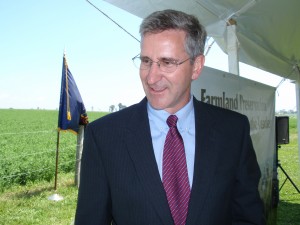
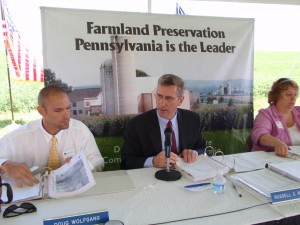

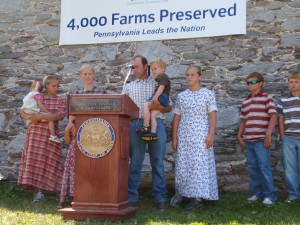
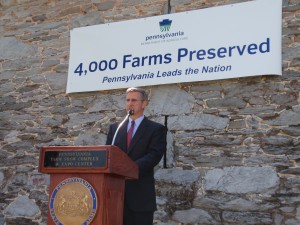

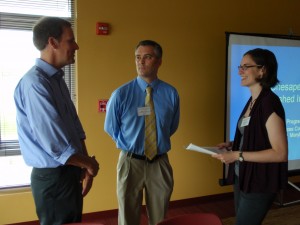
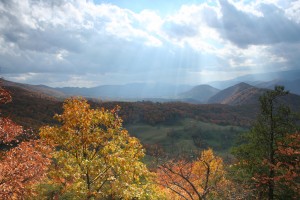

{ 0 comments… add one now }
You must log in to post a comment.